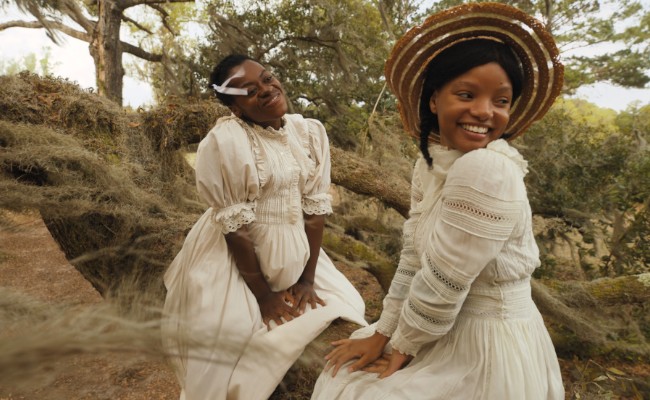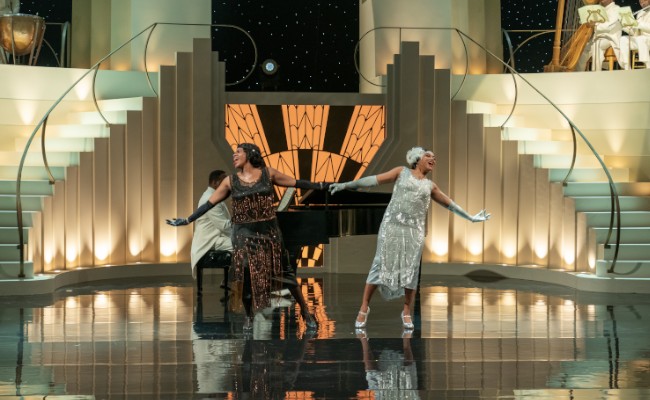
Warner Bros. Pictures
Hollywood seems to have a musical problem. They used to be huge moneymakers — when adjusted for inflation, The Sound of Music made over two billion dollars, for example. They used to rake in the accolades — 10 Best Picture Oscars winners were musicals, including one this century, 2002’s Chicago.
Hollywood wants to keep making them, but has absolutely no clue how to market them. They’re afraid that if audiences know it’s a musical, they won’t come. There are three large-scale musicals coming out in the next few weeks and from their trailers and marketing materials, you’d have no idea. Timothée Chalamet doesn’t sing in a single Wonka trailer. That Mean Girls remake? Surprise! And then there’s The Color Purple, which is not another version of the original novel nor a remake of the Best Picture-nominated film, but a film adaptation of the Broadway musical.
Luckily for us, the best part of The Color Purple is that the film itself is not ashamed to be a musical. It’s big, it’s dancey, it’s practically a filmed stage play — and it’s keeping the medium alive.
As soon as it starts (I just came very close to typing ‘as soon as the show starts’ because that’s exactly what is — a show), from the opening number, we know that we are in for a treat. The scene-setting ‘Huckleberry Pie’ drops us into the world we know from other renditions of the story, transitioning into ‘Mysterious Ways’, a gospel-powered big ensemble number with kicking dancers (a highlight of the film) and a get-up-and-go energy.
It’s a big, bold Broadway musical — and it’s not afraid to be one.
The story remains the same. The Color Purple still follows Celie (Fantasia Barrino, in a stunning film debut), a black woman living in the early 20th century (an oft-unexplored time in stories) American South. She faces innumerable challenges in her life. Her childhood is filled with abuse from her father, who also impregnates her. She’s separated from her sister Nettie (Halle Bailey), whom she eventually believes has died. She marries a man named Mister (Colman Domingo), who continues to abuse her and treat her terribly. When it rains, it pours. For Celie, it’s a cacophonous tempest. She must confront the world head-on as a black queer woman in a truly terrible time to be any of those things.
But you probably know that already. The Color Purple has been in our cultural consciousness since Alice Walker wrote the novel in 1982, winning the Pulitzer Prize for Fiction in 1983. The 1985 film, directed by Steven Spielberg, was the fourth highest-grossing film of that year and received 11 Oscar nominations. The musical adaptation opened on Broadway in 2005, recouped its investment plentifully, and garnered 10 Tony nominations — a 2015 revival won the 2015 Tony for Best Revival of a Musical.
You probably know The Color Purple.
It has also been a star-power generator and solely responsible for some of our great performers, (not to mention the fact that the novel instantly made Walker a household name.) Whoopi Goldberg and Oprah Winfrey (before her eponymous show) exploded into fame thanks to the film and were both nominated for Academy Awards. Four performers in the 2005 Broadway production were nominated for Tonys, with their Celie, LaChanze, taking home the award. And no one who watched the 2016 Tony Awards performance of ‘I’m Here’ will ever forget the name Cynthia Erivo – soon to be Elphaba in the film adaptation of Wicked.

Warner Bros. Pictures
Well, the same is true of this rendition: Fantasia Barrino blows us all away in a remarkable debut performance. It seems weird to call this a debut (even though it technically is) because we all met Fantasia when she won the third season of American Idol almost twenty years ago, when that show was at the height of its powers. She also took over the role of Celie in the original Broadway production. But despite all that, this is her first film role and she is a total stunner. Celie sees such unbelievable (or, unfortunately, totally believable) lows that you really want to see her shine. Fantasia gives her that light, illuminating the brighter parts of the story found almost exclusively in the second act. She gives a big performance straight from the stage — she sings loud, her emotions erupt — she’s everything we want her to be.
The supporting cast is equally first-rate. In fact, since time moves so quickly (three decades pass in 140 minutes, with almost an hour’s worth of music in that time), we don’t get nearly enough time with many of them. Halle Bailey (the finale of her breakout film year), only appears in the early scenes and although I’m not sure her vocal stylings perfectly fit the music of the time, she’s a welcome sight. The two ladies who share the poster with Fantasia, Danielle Brooks (as Sophia, the role made famous by Oprah) and Taraji P. Henson (who knew she could sing like that?) get plenty of screentime, but it isn’t nearly enough. Brooks has been primarily a stage actor (she played the role in the 2015 revival) and cinemagoers might be getting their first taste of her astonishing talent. Meanwhile, Henson cements her status as a multi-hyphenate — she’s officially an actor-singer.
Colman Domingo plays Mister, a truly despicable character, one designed to be hated. Domingo, on the other hand, is a vibrant performer (and a beautiful singer) and (spoilers) his character’s atonement is fundamental to the story’s success. For perhaps the first time in performance history, Domingo achieves that redemption believably. Louis Gossett Jr. (A Raisin in the Sun, Roots) plays Ol’ Mister with similar credibility. The ensemble is rounded out with Corey Hawkins, Jon Batiste, David Alan Grier, and an obligatory cameo from an old friend of the story.
It should also be noted that directors Spielberg (1985 film), Gary Griffin (2005 Broadway), and John Doyle (2015 Broadway) are all white, making Blitz Bazawule the first black director behind a major production of the story. He gives it the perspective it has always needed. Despite being so dark, his film is bright (often literally bright, cinematography by Dan Laustsen is well-lit and clear, a rarity in modern cinema) and colorful and powerful and unapologetic. He understands how musicals work. He has made one of the better ones.
There’s a line in Walker’s novel that is lifted for the film: ‘I think it pisses God off if you walk by the color purple in a field somewhere and don’t notice it.’ Notice the little things, be appreciative of the light, thank your creator. The same can be said of this film: the movie musical is a dying breed. Be grateful for the good ones, thank God for the best ones.
The Color Purple has a run time of 2 hours 20 minutes, and is rated PG-13 for mature thematic content, sexual content, violence and language.
